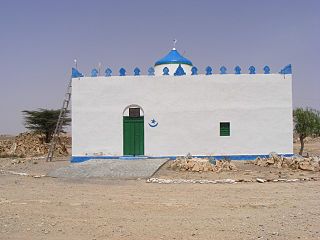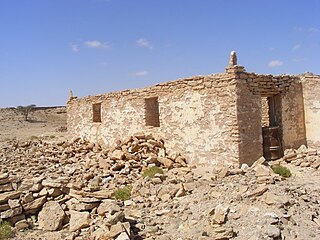Related Research Articles

Las Anod is the administrative capital of the Sool region, currently controlled by Khatumo State forces aligned with Somalia.

The Majeerteen, alternately known as MohammedHarti, are a prominent Somali sub-clan of the Harti, which falls under the Darod conglomerate of clans. Traditionally, they inhabit extensive territories in the Bari, Nugaal, and Mudug regions of Somalia, spanning from Bosaso to Garacad, mainly in Puntland state. Additionally, Majeerteen populations are present in southern towns such as Kismayo.
The Arap or Arab clan is a major Northern Somali clan of the wider Isaaq clan family. The Arap predominantly live on the middle and southwest side of Hargeisa and in the Baligubadle district Hawd region) of Somaliland, with its capital Baligubadle being an exclusively Arap territory. The territory of the clan extends to Ethiopia, in the area of Faafan, Gursum and Dhagahle. The Abdalle Arab, a sub-clan of the Arap clan is based in the Togdheer, Sahil. The Celi Arab, a sub-clan of the Arap clan is based in Maroodi Jeex Hargeisa Muuse celi arab living also Bakool South West State of Somalia Rabdhure Elbarde, They also live Fafan Zone Gursum, Somali Sheekh cismaan Arab based in Nogob Zone Jarar Zone regions.
The Dhulbahante is a Somali clan family, part of the Harti clan which itself belongs to the largest Somali clan-family — the Darod. They are the traditional inhabitants of the physiographic Nugaal in its topographic sense, and its pre-independence administrative sense, which included Doollo. The clan's progenitor is buried at Badweyn.

The Warsangali, alternatively the Mohamoud Harti, are a Somali sub clan, part of the larger Harti branch, which belongs to the Darod clan, one of the largest Somali tribe-families. In the Somali language, the name Warsangali means "bringer of good news." The Warsangali primarily inhabit the Sanaag.

The Darod is a Somali clan. The forefather of this clan is Sheikh Abdirahman bin Isma'il al-Jabarti, more commonly known as Darod. The clan primarily settles the apex of the Horn of Africa and its peripheries, the Somali hinterlands adjacent to Oromia (Ogaden), and both sides of the Kenya–Somalia border. The Darod clan is the largest Somali clan family in the Horn of Africa.

The Harti, (Somali: Harti, Arabic: هرتي, lit. 'strong man'), are a Somali clan that trace their lineage back to SalehAbdi (Harti). They are a sub-clan of the larger Darod clan. Notable sub-clans within Harti include the Majeerteen, Dhulbahante, and the Warsengeli. They predominantly reside in the apex of the Horn of Africa and its surrounding regions. Furthermore, in the southern territories, the clan's settlements span both sides of the Kenya-Somalia border.
Yagori is a town in the northern Sool Region ofSomaliland.

Garad Jama Garad Ali is the 21st supreme traditional clan Sultan (Garaad) of the Dhulbahante. He has significant influence in Somalia's current politics, particularly in Ssc-Khatumo.

Osman Mahamuud, also known as Uthman III ibn Mahmud, was a Somali king. He led the Majeerteen Sultanate during the 19th century.
Garad is a term used to refer to a king, Sultan or regional administrator. It was used primarily by Muslims in the Horn of Africa that were associated with Islamic states, most notably the Adal Sultanate.
Ali Duh Gorayo was a popular poet from Somalia, who hailed from the city of Buuhoodle, in the Togdheer, Somalia but grew up in the Nugaal region now Sool (las-Anod) and Dollo region in Ethiopia. He mostly wrote about camel husbandry and the issues affiliated with the profession of camel riders.
Gudban is a 1907 poem and oration by Muhammad Abdullah Hassan, the leader of the darawish, announcing his policy declaration. It was one of many orations and poems which were salvaged after Maxamed Aadan Sheekh, Somalia's Minister of Culture ordered for them to be salvaged, but only permitted poems which were memorized by former members of the Haroun. The Gudban poem in particular, was transmitted in 1957 by the darawish veteran Garaad Soofe Durraan. The darawish referred to the poem as Gaala leged, which could be translated from Somali to English as Defeating the Infidels. Non-darawish Somalis referred to the poem as Gudban, which is a Somali word that literally means "moving across". This was in reference to how during the year it was released, the darawish moved back into their old territories in the Nugaal Valley.
Haroun, also called Fadhiweyn, and natively transliterated as Xarunta in Somali, was a government and headquarters of the Dervishes, headed by Faarax Mahmud Sugulle. According to Claude Edward Marjoribanks Dansey, the political officer in the British Somali Coast Protectorate consisted of 400 individuals. The capture of the haroun was regarded as conceivably resulting in the Sayyid's surrender. In the third expedition, major Paul Kenna was tasked "by every means" to find where the haroun is.
Afbakayle is a 1905 poem by the Sayid Mohammed Abdullah Hassan made while he was in exile. The poem is a political poem which primarily deals with the topic of treachery and two-facedness, known as jeesjeesnimo in Somali. According to scholar Abdulqadir Sheik Abdi, the poem is a direct denunciation of those described as "friendly tribes" by the British, whom he describes as the Sayid's sworn arch-enemies. A repeated mantra in the poem used to describe the Somali colonial collaborators is naga ajoon waayey, meaning won't even flinch.

The Mohamoud Garad is a Somali clan. Its members form a part of the Dhulbahante, a sub-division of the Harti/Darod clan-family. The clan is divided into three main sub-clans ― namely the Jama Siad, the Ugaadhyahan and Omar Wa’eys.

The Farah Garad or the Garad Farah is a Somali clan which is part of the Dhulbahante clan-family, a sub-division of the larger Harti/Darod clan. The Farah Garad are divided into two sub-clans — Yassin Garad and Abdalla Garad. Abdalla has four clan eponyms, Ahmed Garad, Mohamed Garad (Baharsame), Guled Garad (Barkad) and Ali Garad. They are largely significant in Sool and Togdheer regions of Somaliland, and Dollo Somali region of Ethiopia.
'SSC or HMB-SSCUnity and Salvation Authority of the SSC regions of Somalia' or HBM-SSC was the name of the self-proclaimed autonomous government of the Dhulbahante clan living between Somaliland and Puntland, which was active from 2009 to around 2012. It claimed possession of the so-called SSC regions of Sool (S), Sanaag (S), and Cayn (C).
The Dhulbahante Garadship begun in the 16th century, as a successor to the Sultanate of Adal with Garad Shishore assuming the royal title in approximately 1530. The current Garad, Garad Jama Garad Ali hails from this long line of succession.

Garad Jama Garad Ismail Duale is the third-highest traditional leader in the Sool region of SSC-Khaatumo State of Somalia
References
- 1 2 Coleman, James (2021). Political Parties and National Integration in Tropical Africa. p. 544.
- 1 2 Quennell, Peter (1960). History Today. p. 524.
Such was their belief in him that when the Sultan of the Dolbahanta , Ali Gerad , defected from the Derwish cause , his own son pleaded for the privilege of killing him, "It is meet that the infidel father be put to death by the believing son who is deprived of a place in paradise".
- ↑ 1856, First Footsteps in Africa
- ↑ "Official History of the Operations in Somaliland, 1901-04". 1907.
- ↑ Douglas Jardine. p.74
- ↑ Oral Poetry and Somali Nationalism, p 104
- ↑ I.M. Lewis p 204
- 1 2 I.M. Lewis p 204 & p 100
- ↑ Coleman, James (1966). Political Parties and National Integration in Tropical Africa. p. 545.
- ↑ Lewis, IM (1999). A Pastoral Democracy. pp. 208–209.
- ↑ Abdisalam M. Issa-Salwe (1996). The Collapse of the Somali State: The Impact of the Colonial Legacy. HAAN. ISBN 978-1-874209-27-0.
- ↑ "Oral Poetry and Somali Nationalism: The Case of Sayid Mahammad 'Abdille Hasan (African Studies) - PDF Free Download". epdf.pub.
- ↑ DHURWAA ARIGA EEBBAA LEH, Diiwaanka Gabayadii, 1999
- ↑ Pubblica Istruzione, Ministero (1966). Somaliya: antologia storico-culturale. p. 73.
The Sultan of the Dolbahanta gave the Mullah his daughter in wedlock , and three thousand men rallied to his leadership ; Arab slavers on the coast provided sixty guns